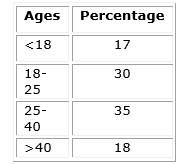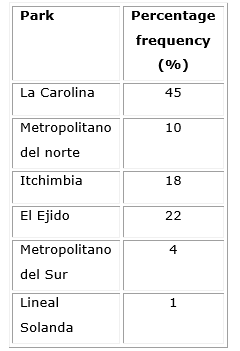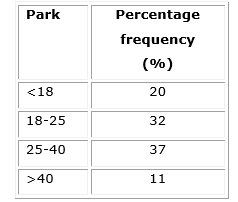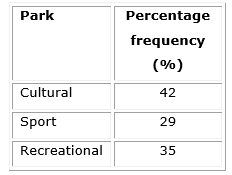INTRODUCTION
Green spaces are essential for sustainable urban development. Parks, squares along with urban trees not only largely define the identity and attractiveness of cities, but also contribute to life quality of its inhabitants.1,2
The life quality concept has begun to be increasingly used in the health assessments field or as a well-being measure.3) The concept dates back to United States after World War II, as an attempt by researchers at time to know people's perception of whether they had a good life or if they felt financially secure.4) For some authors, this concept originates in order to distinguish relevant results for health research, derived from early research on subjective well-being and life satisfaction;5,6,7 that in the parks case, health is also an perception intrinsic mode.8
Public parks and recreation are capable of health improving and general well-being of a nation, they are essential spaces to combat some of the most complicated challenges facing each country: poor nutrition, hunger, obesity and physical inactivity. Parks and recreation agencies improve health outcomes effectively and, therefore, should receive support through national and community funds and policies that allow them to continue expanding their efforts to achieve a positive change in health and welfare.5
The parks constitute small paradises in the cement, they are a complementarity and correspondence sign of nature with human being, they are thought of as creativity centers, culture, recreation, opposites that add, overlap and mesh; generate life and synergy, comfort, feed back; The parks are health synonyms.
This study focuses from semiosis, which responds in particular to generating belonging, dichotomous value to nationalism from "emblematic" of the parks, and it is precisely this condition, from which one of the first nerve points of study emerged, since the term is not assertively conceptualized which did not allow obtaining a concrete response through Quito-Ecuadorian citizenship. The aforementioned was evidenced in contrast to Madrid-Spanish citizenship, which was clear about the term, and could respond consciously to information gathering, as will be shown below.
Among the parks to study in Quito city is the South Metropolitan Park that has a historical characteristic, in addition the issue of its extension is also important as it entails representativeness; the Metropolitan Guanguiltagüa, also fulfills a historical character, both are basically forests with this particularity, so their sense is different in usability relation, since they additionally offer a more intimate encounter with nature. The Linear Park (denominated in several ways according to river area), follows the course of Machángara River since although it did not exist as such, historically in its route activities were developed: such as fishing, recreation, clothes laundry of surrounding families and ancestral medicine after the medicinal herbs extraction, etc.9
The La Carolina park, also fulfills that character, although all are relatively new parks in relation to Alameda and El Ejido. This park is an Central Park analogy, has similar characteristics and around it is also one of the city's business centers, shopping centers and meets the having led aspect to a high surplus value, among others.10
In Madrid there are also several parks considered as emblematic among which were considered for this study: the Retiro Park, Parque del Este or Jardines de Sabatini and Parque del Oeste, according to geographical location criteria. The Retiro Park, located in the Independencia Plaza, with an area of 537.83 hectares and more than 15,000 trees, is a green backwater in Madrid center, located southeast of the historic center. The Jardines de Sabatini are located in front of Royal Palace north facade, between Bailén Street and the Cuesta de San Vicente, on a terrace hanging over the Campo del Moro. It is a neoclassical garden in keeping with the palace. The Parque del Oeste is a park in Spanish city of Madrid, located between the La Coruña road, the University City and the Moncloa district. The Capricho Park is a park and green area located in the Alameda de Osuna neighborhood, in Barajas district, northeast of Madrid city.
Several international organizations have addressed the parks problem, for example the World Health Organization (WHO) raises the need to have a minimum of 9 m2 of green space per person with an ideal UGS value of 50 m2 per capita.11 Everything that relates to factors such as sustainable cities and better health and basic health indicators to monitor progress and identify its success, so this natural environment must meet conditions such as: availability, accessibility, quality and safety.
The National Recreation and Park Association mentions that “public parks and recreation are leaders in improving the health and general well-being of a nation, they are essential partners to combat some of the most complicated challenges facing the United States.12) The character that these parks acquire semiotically is symbolic, identitarian and nationalist because their representativeness is universal, a clear example of this is The Central Park spread through a number of films, in which it has taken a central role, and has identified as the heart of New York, generating a strong diffusion to make it a mandatory step icon when visiting this city, which in turn generates resources for its maintenance.
After pointing out the parks around health relevance, it is important to get into Semiotics, which Ferdinand de Saussure defines as: “a science that role studies of signs as part of social life”.13 Lotman's semiotics proposes a dynamic character to meaning concept, therefore to its formalized manifestation: the text. It allows to exceed the strict limits of a “sign” traditional definition for a more dynamic and complex approach. This importance of “meaning” is key in the study because the way of perception of citizens regarding parks as dichotomous to the health base of study depends on it.
From the importance assigned by Lotman to “meaning” as the dynamic element in cohesion / coherence of a text, the culture notion as a semantic nature other than human beings tends to expand, which members of an organization believe by consensus which is a shared relationship with the senses,14,15 in this note it refers specifically to citizens perception way about dichotomous health to parks analyzed in this study.
The Semiosphere, a term used in this work, is a semiotic space, a condition, a prerequisite, necessary for communication implementation and the existence of its work. Language in this context is considered as a function, a clot of semiotic space. It is the space in which all the participants of the communication are initially immersed and that guarantees the operation of a device consisting of a recipient, and a channel that connects them; semiosis being possible.16
Other important contributions on the question term are “By semiosis, I understand an action, an influence that is, or supposes a cooperation of three subjects, such as a sign, its object and its interpreter, tri-relative influence that in no case can end in an action between couples”.17
To the extent that perception plays a preponderant role, it speaks of a certain materiality. In abstract, the materiality of a signifier lies in the fundamental need to be perceived; But it also comes down to it. Its linguistic evaluation begins after the "ontological or phenomenological fact", as it manifests. 18 In this way, the semiosphere is the set of signs with which everyone interacts. The signs are representations that form a delimited space with respect to surrounding one, understood as extrasemiotic.
In this way the semiosphere is constituted by the signs system around the mentioned parks, being the main and axis of this study the health, since the same in turn is triadic and correlational to sport and recreation, as own activities of these green environments, since there is no other space that conditions them as their own.
The paper objective is to determine the parks semiosphere around health, based on the citizens perception in selected emblematic parks of the Quito and Madrid cities.
METHODS
A mixed investigation was carried out, by proposing both a qualitative and quantitative analysis reflected both in the art state, and by surveys to measure citizen perception, tabulated at research different stages. Semiotics was used as a methodological tool to decode sign systems and perception through the senses (multisensory).
The respondents number was determined according to population density in the area surrounding each park, with respect to representative sociocultural sample of each case. 2000 citizens in Quito and 2000 in Madrid were surveyed.
RESULTS
Below are the some questions results of the survey applied in the Quito emblematic parks (table 1).
As can be seen, the surveys were mainly carried out for people aged between 25-40 years and 18-25 years.
The respondents distribution in the selected parks is shown in table 2.
Most of the respondents are located in La Carolina, El Ejido and Ithimbia Park, as can be seen in the previous table. Table 3 shows the parks considered emblematic by the respondents.
Table 3 Percentage Frequency of parks considered emblematic
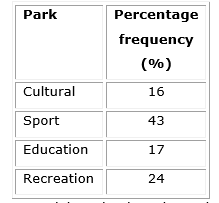
Source: Own elaboration based on tabulation.
According to citizens perception, the parks that are most considered emblematic are La Carolina, El Ejido and Alameda, with the highest frequency values. In activities relation that are considered to be promoted in the parks, the results are shown in Table 4.
Table 4 Absolute frequency of activities to be enhanced

Source: Own elaboration based on tabulation.
Citizens considered that especially sports (43 %) and recreation (24 %) should be enhanced in the Quito parks.
Below are the some questions results of the survey applied in the Madrid emblematic parks.
As in Quito, the majority of Madrid respondents are in age ranges of 25-40 and 18-25 years. Table 6 shows the activities percentage frequency that citizens consider most important in the park that they consider emblematic.
Table 6 Percentage frequency of importance accorded to activities
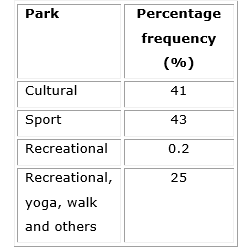
Source: Own elaboration based on tabulation.
In the citizens Madrid case, it was recognized that the most important activities in the emblematic parks are sports (43 %) and cultural (41 %), and hardly any importance was considered the recreation. Regarding the activities that should be parks promoted, the results are shown in table 7.
In this case, it was considered that cultural activities (42%) and recreational activities (35%) are the ones that should be enhanced in Madrid's parks.
DISCUSSION
According to the study of the National Institute of Statistics and Censuses of 2010, in the Quito case there are 20.4 m2 of green areas per capita, the third highest in the country, so it exceeds the figure by twice those recommended internationally.19)
The parks that are located in the Quito Metropolitan District, in addition to offering ample spaces for sports and recreation, help to improve the life quality of all inhabitants in the urban system, which confirms the condition of health becoming synonymous.
In above relation, in Sendarrubia's work,20 a very good degree of this standard is ratified, 25 urban green sites are cited. According to City Council data, the Spain capital has 6,400 hectares of areas with vegetation, for each person there are more than 20 square meters of public green areas, a figure that exceeds the WHO recommendation that cities have the minimum mentioned.
Carrying out a comparative analysis regarding this point, and considering that Madrid constitutes the replica model, it can be affirmed with satisfaction that Ecuador and Quito promptly fulfill this need intrinsically to health of citizens satisfactorily. It is essential to mention that studies of this nature, promote knowing the indigenous roots and favor that future generations feel pride in everything that generates identity as it constitutes this parks health hemisphere, only in this way can we influence the national public policies, and contribute to nation development.21
In this way, the following can be added: the parks characterization denotes the reason for emblematic denomination since each one has a unique milestone, which within the city makes it a notable reference in relation to other green areas.
In the survey the respondents majority correspond to 35% with an age range of 25 to 40 years, the general range includes the ages of 18 to 40. In relation to the fact that in the parks there may be some element that can be considered dangerous, 58% said yes in Quito, and 36% in Madrid. In the case of first city, citizens said that it is necessary to increase police personnel in each park, since in this way their security perception would be stronger.
The most frequent schedules of people in the parks are from 06:00 a.m. to 12:00 p.m. in Quito and from 12:00 p.m. to 6:00 p.m. in Madrid. On average in both cities people frequent a park between 2 and 3 hours a day. In Quito, the cap located in more than 5 hours corresponds to Guangüiltagua, La Carolina and Itchimbía Metropolitan Parks. In Quito, 56% of respondents state that the municipal government wastes economic resources due to park underutilization; what in Madrid is 42%.
Most respondents in both cities said that the media does not influence people to parks attend. However, the review of local print media shows that press definitely influences the information presented to public about the parks and their individual opinion. In addition, it is not only about this subject, but also about many others, reproducing objective information or not.
The people majority surveyed consider that there are no characters that represent or are emblems within a park, which constituted another controversy as a response from the semiotic view point, and was also considered as a question to reassess in later works.
The results showed that the activity that should be mainly promoted is sport followed by recreation, which in a certain way also represents that the public is not interested in learning, nor in cultivating otherwise in the Quito case. While in Madrid, recreation and cultural activities were more frequent.
It can be concluded or ratified what was mentioned during this study, that the parks are dynamic institutions that play a vital role, not fully validated, or even understood their role in the social, economic development and physical well-being of urban areas of the two cities studied.
Well-maintained urban parks promote community participation and civic pride, attract and connect people of all ages and ethnic groups who share a vision for environment improvement, can also become vital assets of the community when civic groups and leaders join. The parks offer opportunities for people to take possession of their community, which improves their life quality and also helps control urban sprawl. Not without reason the WHO regulates the square meters of green areas per inhabitant, nationally we almost exceed three times this condition, which is a positive indicator.
However, the indicators mentioned in the semiosphere of all this work such as: administration, which in some cases is outsourced, security that is not optimal, and the factors that specifically generate the emblematic such as monuments, do not constitute a concern point for authorities in charge since they go unnoticed and even their authorship is unknown, which generates ignorance of the public and an identity impairment, therefore these emblems do not fulfill their social function, nor what promotes health, sports and the recreaction.
In spite of all the benefits of these green lungs, they do not receive the necessary attention from the authorities in charge, since the people disagreement in relation to administrations is manifested, the cost benefit is not justified because their usability is minimal, and in this semiosphere the direct relationship that parks have with health is evidenced through activities such as sports and recreation, re-ground through the information gathering; however, its repowering around the use of these green spaces is not encouraged.
Based on the above, it is also considered that sport should be enhanced and make this the main icon of each park trying to have more resources and generate more influx of parks people, points that are additionally contrasted, based on the misperception about the emblematic. It is definitive that both sport and recreation are health activities intrinsic of citizens not only of Quito or Madrid, but also a common factor.
For this, it is recommended to generate more studies of this nature in order to identify the key points that lack attention, supporting the expansion of related studies, so that they do not constitute only an archived document, but studies that affect public policies, since that health is the determining axis of life quality.22,23













